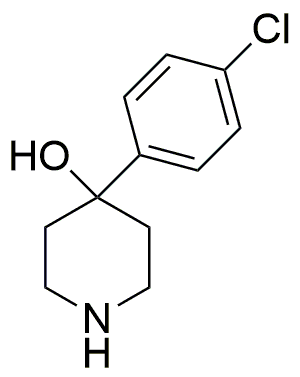4-(4-Chlorophenyl)-4-hydroxypiperidine is widely utilized in research focused on:
- Pharmaceutical Development: This compound serves as a key intermediate in the synthesis of various pharmaceuticals, particularly in the development of analgesics and antidepressants, enhancing therapeutic efficacy.
- Neuroscience Research: It is used in studies investigating neurotransmitter systems, helping researchers understand the mechanisms behind mood disorders and potential treatments.
- Analytical Chemistry: The compound is employed in the formulation of analytical standards for chromatography, aiding in the accurate detection and quantification of related substances in complex mixtures.
- Material Science: Its unique properties make it suitable for creating specialized polymers and coatings, which are used in electronics and protective materials.
- Biochemical Assays: This chemical is utilized in various biochemical assays to evaluate the activity of enzymes and receptors, providing insights into drug interactions and biological pathways.
General Information
Properties
Safety and Regulations
Applications
4-(4-Chlorophenyl)-4-hydroxypiperidine is widely utilized in research focused on:
- Pharmaceutical Development: This compound serves as a key intermediate in the synthesis of various pharmaceuticals, particularly in the development of analgesics and antidepressants, enhancing therapeutic efficacy.
- Neuroscience Research: It is used in studies investigating neurotransmitter systems, helping researchers understand the mechanisms behind mood disorders and potential treatments.
- Analytical Chemistry: The compound is employed in the formulation of analytical standards for chromatography, aiding in the accurate detection and quantification of related substances in complex mixtures.
- Material Science: Its unique properties make it suitable for creating specialized polymers and coatings, which are used in electronics and protective materials.
- Biochemical Assays: This chemical is utilized in various biochemical assays to evaluate the activity of enzymes and receptors, providing insights into drug interactions and biological pathways.
Documents
Safety Data Sheets (SDS)
The SDS provides comprehensive safety information on handling, storage, and disposal of the product.
Product Specification (PS)
The PS provides a comprehensive breakdown of the product’s properties, including chemical composition, physical state, purity, and storage requirements. It also details acceptable quality ranges and the product's intended applications.
Certificates of Analysis (COA)
Search for Certificates of Analysis (COA) by entering the products Lot Number. Lot and Batch Numbers can be found on a product’s label following the words ‘Lot’ or ‘Batch’.
*Catalog Number
*Lot Number
Certificates Of Origin (COO)
This COO confirms the country where the product was manufactured, and also details the materials and components used in it and whether it is derived from natural, synthetic, or other specific sources. This certificate may be required for customs, trade, and regulatory compliance.
*Catalog Number
*Lot Number
Safety Data Sheets (SDS)
The SDS provides comprehensive safety information on handling, storage, and disposal of the product.
DownloadProduct Specification (PS)
The PS provides a comprehensive breakdown of the product’s properties, including chemical composition, physical state, purity, and storage requirements. It also details acceptable quality ranges and the product's intended applications.
DownloadCertificates of Analysis (COA)
Search for Certificates of Analysis (COA) by entering the products Lot Number. Lot and Batch Numbers can be found on a product’s label following the words ‘Lot’ or ‘Batch’.
*Catalog Number
*Lot Number
Certificates Of Origin (COO)
This COO confirms the country where the product was manufactured, and also details the materials and components used in it and whether it is derived from natural, synthetic, or other specific sources. This certificate may be required for customs, trade, and regulatory compliance.


